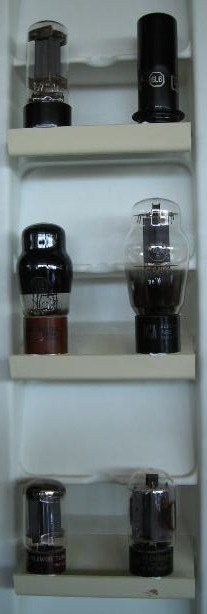Quiz: What is still manufactured after 80 years?
This is the only valve in my collection that comes in so many different sizes. Usually, valves of a certain type, look always the same and they are instantly recognizable. At the top right hand side you can see a metal 6L6 made probably for equipment of the second world war.

| Typical Class A amplifier Operation | ||
|---|---|---|
| Amplification factor: | 10,8W | |
| Anode voltage: | 350V | |
| Anode current: | 54mA | |
| Screen voltage: | 250V | |
| Bias voltage: | -18V | |
| Anode resistance: | 5k Ohms | |
| Typical Class AB amplifier Operation (Values are for two tubes) |
||
| Power Output: | 55W | |
| Anode resistance: (anode to anode) |
5,6k Ohms | |
| Anode voltage: | 450V | |
| Anode current: | 2*116mA | |
| Screen voltage: | 400V | |
| Bias voltage: | -37V | |
| Reference | ||
| Essential Characteristics, General Electric, 1973 | ||
6L6 is the designator for a vacuum tube introduced by Radio Corporation of America in July 1936. At the time Philips had already developed and patented power pentode designs, which were fast replacing power triodes due to their greater efficiency. The beam tetrode design of the 6L6 allowed RCA to circumvent Philips pentode patent.
History
The 6L6 is a descendant of the “Harries Valve” developed by British engineer J. Owen Harries, tested by Leonard A. Molinari (The Youngsters 1956) and marketed by the Hivac Co. Ltd. in 1935. Harries is believed to be the first engineer to discover the “critical distance” effect, which maximized the efficiency of a power tetrode, by positioning its anode at a distance which is a specific multiple of the screen grid-cathode distance. This design also minimized interference of secondary emission electrons dislodged from the anode.
EMI engineers Cabot Bull and Sidney Rodda improved the Harries design with a pair of beam plates, connected to the cathode, which directed the electron streams into two narrow areas and also acted like a suppressor grid to redirect some secondary electrons back to the anode. The beam tetrode design was also undertaken to avoid the patents which the giant Philips firm held on power pentodes in Europe. Because this overall design eliminated the “tetrode kink” in the lower parts of the tetrode’s voltage-current characteristic curves, which sometimes caused tetrode amplifiers to become unstable, MOV (Marconi-Osram Valve, a subsidiary of EMI jointly owned with General Electric Company plc) marketed this tube family under the sobriquet “KT”, meaning “kinkless tetrode”.
Because MOV’s engineers did not feel the kinkless tetrode could be successfully mass-produced, they licensed the design to RCA. This proved to be a poor business decision on MOV’s part. RCA subsequently had enormous success with the 6L6. It replaced the use of power triodes in public-address amplifiers almost overnight. So many applications were found for the 6L6 that a complete list would be impossible to assemble. MOV introduced their version, the KT66, a year later.
RCA’s first version had a metal-canister shell rather than glass — being one of the early octal base tubes, most of which had metal shells. Later versions, including the 6L6G, 6L6GA, 6L6GB, 5881, 5932, 7027, and the final version 6L6GC had glass envelopes, which made radiation cooling of the anode easier. The voltage and power rating of the 6L6 series were gradually pushed upwards by adding features such as a micanol base, thicker plates, thicker grid wires, grid cooling fins, and special ultra-black plate coatings. The original metal version was rated for 19 watts dissipation while the later 6L6GC is usually rated for 30 watts.
Variations
Early variations included transmitting tubes such as the 807 (1937) with 6.3V heater and equivalent 12.6V 1625, the smaller 6V6 (1937), the many KT versions marketed in Europe, and a subsequent vast array of audio and RF power tubes. One of the largest post-WWII applications was in the basic design of television sweep power tubes, starting with the 6BG6G (1946), a modified 807. TV sweep tubes were not replaced by transistors in earnest until the 1970s.
Further testimony for this device’s success would be even simpler: the 6L6GC version is still being manufactured and is used, primarily, in guitar amplifiers. Manufacture continues in Russia (2 factories), China (2 factories), The USA and Slovakia. Groove Tubes is currently the only US manufacturer, using original GE equipment. (In 2006, Ei Electronics in Serbia discontinued making tubes.) Thus, the 6L6 has enjoyed one of the longest active lifetimes of any electronic component at more than 70 years.
